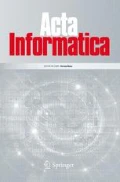Summary
Three notions of distance for measuring the synchronic dependence of transition firings in Petri nets are studied. For the first two notions we present algorithms for obtaining a basis of the linear space of weight vectors for which the distance is finite, and methods for computing the distance for any given weight vector by examining a finite set of vectors obtained a priori. For the third notion of distance, the problem of deciding whether a given weight vector yields a finite distance is shown to be equivalent to the reachability problem. Finally it is shown that a basis of the linear space of weight vectors for which the weighted sum of token counts is bounded over all reachable markings can be obtained effectively. Also some complexity results are given.
Similar content being viewed by others
References
André, C., Armand, P., Boeri, F.: Synchronic relations and applications in parallel computation. Digital Process. 5, 99–113 (1979)
Araki, T., Kasami, T.: Some decision problems related to the reachability problem for Petri nets. Theor. Comput. Sci. 3, 85–104 (1977)
Genrich, H.J., Lautenbach, K., Thiagarajan, P.S.: Elements of general net theory. In: Net Theory and Applications, Lecture Notes in Computer Science 84, Berlin, Heidelberg, New York: Springer 1980
Goltz, U., Reisig, W.: Weighted synchronic distance. In: Applications and Theory of Petri nets, Informatik-Fachberichte, pp. 289–300. Berlin, Heidelberg, New York: Springer 1982
Hack, M.: Decision problems for Petri nets and vector addition systems. Computation Structure Group Memo 95-1, Project MAC, Massachusetts Institute of Technology, Cambridge, MA, 1974
Karp, R., Miller, R.: Parallel Program Schemata. J. Comput. Systems Sci. 3, 147–195 (1969)
Kluge, W.E., Lautenbach, K.: The orderly resolution of memory access conflicts among competing channel processes. IEEE Trans. Computers C-31, 194–207 (1982)
König, D.: Theorie der endlichen und unendlichen Graphen. Akademische Verlagsgesellschaft, Leipzig 1936
Kosaraju, S.R.: Decidability of reachability in vector addition systems. Proc. 14th Annual ACM Symposium Theory of Computing, pp. 267–281, 1982
Lipton, R.: The reachability problem and the boundedness problem for Petri nets are exponential-space hard. In: Conference on Petri Nets and Related Methods, M.I.T., 1975
MacLane, S., Birkhoff, G.: Algebra. New York: Macmillian 1967
Mayr, E.W.: An algorithm for the general Petri net reachability problem. Proceedings of the 13th Annual ACM Symposium on Theory of Computing, pp. 238–246, 1981
Murata, T., Le, V.B., Leu, D.J.: A method for realizing the synchronic distance matrix as a marked graph. Proceedings of the 1982 IEEE International Symposium on Circuits and Systems, 1982
Peterson, J.L.: Petri Net Theory and the Modelling of Systems. Prentice-Hall, 1981
Petri, C.A.: Interpretations of net theory. Interner Bericht 75-07, ISF-GMD, 1975
Suzuki, I., Kasami, T.: Characterization of weight vectors for weighted synchronic distance in Petri nets. Proc. 20th Allerton Conference on Communication, Control and Computing, pp. 406–415, 1982
Author information
Authors and Affiliations
Rights and permissions
About this article
Cite this article
Suzuki, I., Kasami, T. Three measures for synchronic dependence in Petri nets. Acta Informatica 19, 325–338 (1983). https://doi.org/10.1007/BF00290730
Received:
Issue Date:
DOI: https://doi.org/10.1007/BF00290730




